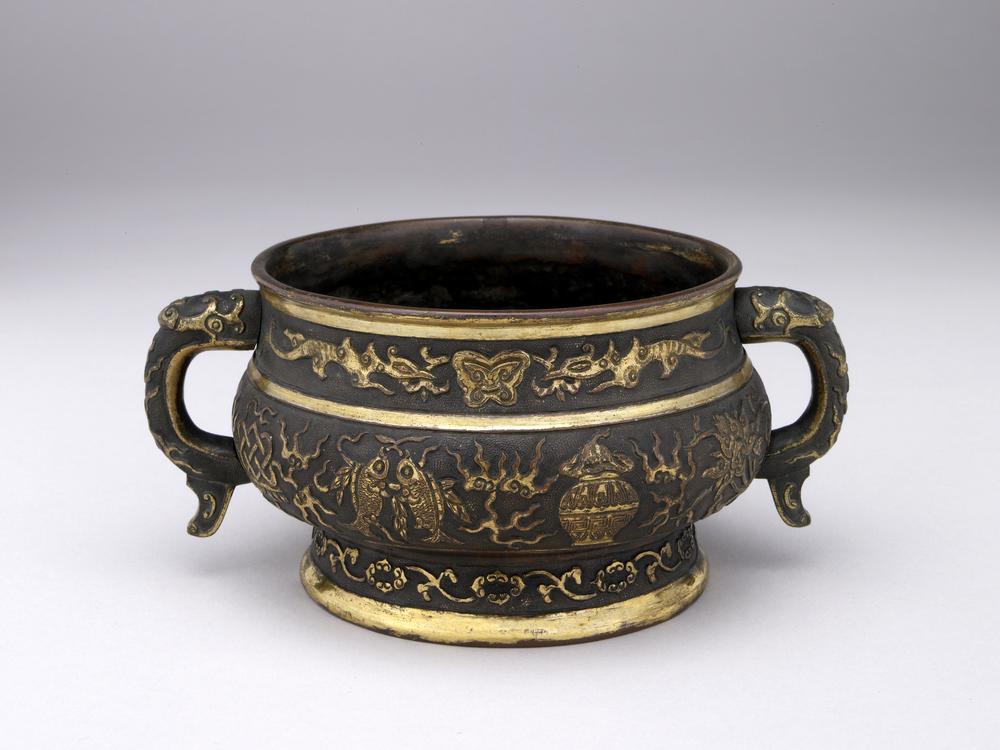Period:Unknown Production date:16thC
Materials:paper
Technique:painted
Subjects:landscape
Dimensions:Height: 108.50 centimetres (mount) Height: 25.20 centimetres Width: 70 centimetres (mount) Width: 52.60 centimetres
Description:
Fan painting, mounted as hanging scroll. Mountain landscape: rows of jagged peaks; cascade from lofty peak in left; in right, lake and scenery along opposite shore in distance. Ink and gold ink on paper. Sealed.
IMG
![图片[1]-fan-painting; hanging scroll BM-1881-1210-0.603-China Archive](https://chinaarchive.net/Unknown/Paintings/mid_00235851_001.jpg)
![图片[2]-fan-painting; hanging scroll BM-1881-1210-0.603-China Archive](https://chinaarchive.net/Unknown/Paintings/mid_00030638_001.jpg)
![图片[3]-fan-painting; hanging scroll BM-1881-1210-0.603-China Archive](https://chinaarchive.net/Unknown/Paintings/mid_00552837_001.jpg)
![图片[4]-fan-painting; hanging scroll BM-1881-1210-0.603-China Archive](https://chinaarchive.net/Unknown/Paintings/mid_BM_JP0373_006.jpg)
![图片[5]-fan-painting; hanging scroll BM-1881-1210-0.603-China Archive](https://chinaarchive.net/Unknown/Paintings/mid_BM_JP0373_002.jpg)
![图片[6]-fan-painting; hanging scroll BM-1881-1210-0.603-China Archive](https://chinaarchive.net/Unknown/Paintings/mid_BM_JP0373_003.jpg)
![图片[7]-fan-painting; hanging scroll BM-1881-1210-0.603-China Archive](https://chinaarchive.net/Unknown/Paintings/mid_BM_JP0373_004.jpg)
![图片[8]-fan-painting; hanging scroll BM-1881-1210-0.603-China Archive](https://chinaarchive.net/Unknown/Paintings/mid_BM_JP0373_005.jpg)
![图片[9]-fan-painting; hanging scroll BM-1881-1210-0.603-China Archive](https://chinaarchive.net/Unknown/Paintings/mid_BM_JP0373_001.jpg)
Comments:This may be an imaginary view of Mt. Lu, celebrated in the verses of the Chinese poet Li Bo. Terutada Shikibu was a professional ink painter who worked in eastern Japan in the mid-16th century, in the style established earlier by Kei Shokei in Kamakura. (Label copy, TTC 1996) Smith et al 1990Nothing is known of this artist, whose seal Ryukyo appears on a number of paintings in the late Muromachi ink style. The folding-fan form was much liked by Japanese and Korean artists, possibly because its distortions of space gave opportunities for them to create a sense of movement and mood, rather than the rationally expressive grandeur central to Chinese landscape painting. In any case, it was clearly never folded and actually used as a fan like the much later painting by Buncho (1973, 0226, 058). The mingling of strong ink strokes with pale ink wash and gold shows the influence of the Kano school of artists, who by the mid-sixteenth century were beginning to dominate Japanese painting in the ‘Chinese’ tradition.FURTHER READING Rosenfield, J. M. (ed.), ‘Song of the Brush: Japanese Paintings from the Sanso Collection, Seattle’, Seattle Art Museum, 1979. Hizo Nihon bijutsu taikan Vol 3Foreground, middle-ground, and background alike are occupied by rows of jagged peaks; from a lofty peak on the left-hand side of the picture falls a cascade, while on the right-hand side, separated from the cascade by a mist done in gold paint, the opposite shore of a lake and the scenery along it can be seen in the distance. The artist takes full account of the special nature of the curving surface presented by a fan face, painting individual views with care and disposing them skillfully so as to create a whole that, small though it is, has a strange, compelling power. The motives in this work were probably suggested by Lushan, familiar through the poetry of Li Bo, so that it is also in a sense a kind of ‘meisho-e’, “picture of a famous scenic spot.” ‘603. A very good example.’ ‘龍杏’ (unattributed annotations in the specially interleaved Japanese Study Room copy of Anderson 1886)
Materials:paper
Technique:painted
Subjects:landscape
Dimensions:Height: 108.50 centimetres (mount) Height: 25.20 centimetres Width: 70 centimetres (mount) Width: 52.60 centimetres
Description:
Fan painting, mounted as hanging scroll. Mountain landscape: rows of jagged peaks; cascade from lofty peak in left; in right, lake and scenery along opposite shore in distance. Ink and gold ink on paper. Sealed.
IMG
![图片[1]-fan-painting; hanging scroll BM-1881-1210-0.603-China Archive](https://chinaarchive.net/Unknown/Paintings/mid_00235851_001.jpg)
![图片[2]-fan-painting; hanging scroll BM-1881-1210-0.603-China Archive](https://chinaarchive.net/Unknown/Paintings/mid_00030638_001.jpg)
![图片[3]-fan-painting; hanging scroll BM-1881-1210-0.603-China Archive](https://chinaarchive.net/Unknown/Paintings/mid_00552837_001.jpg)
![图片[4]-fan-painting; hanging scroll BM-1881-1210-0.603-China Archive](https://chinaarchive.net/Unknown/Paintings/mid_BM_JP0373_006.jpg)
![图片[5]-fan-painting; hanging scroll BM-1881-1210-0.603-China Archive](https://chinaarchive.net/Unknown/Paintings/mid_BM_JP0373_002.jpg)
![图片[6]-fan-painting; hanging scroll BM-1881-1210-0.603-China Archive](https://chinaarchive.net/Unknown/Paintings/mid_BM_JP0373_003.jpg)
![图片[7]-fan-painting; hanging scroll BM-1881-1210-0.603-China Archive](https://chinaarchive.net/Unknown/Paintings/mid_BM_JP0373_004.jpg)
![图片[8]-fan-painting; hanging scroll BM-1881-1210-0.603-China Archive](https://chinaarchive.net/Unknown/Paintings/mid_BM_JP0373_005.jpg)
![图片[9]-fan-painting; hanging scroll BM-1881-1210-0.603-China Archive](https://chinaarchive.net/Unknown/Paintings/mid_BM_JP0373_001.jpg)
Comments:This may be an imaginary view of Mt. Lu, celebrated in the verses of the Chinese poet Li Bo. Terutada Shikibu was a professional ink painter who worked in eastern Japan in the mid-16th century, in the style established earlier by Kei Shokei in Kamakura. (Label copy, TTC 1996) Smith et al 1990Nothing is known of this artist, whose seal Ryukyo appears on a number of paintings in the late Muromachi ink style. The folding-fan form was much liked by Japanese and Korean artists, possibly because its distortions of space gave opportunities for them to create a sense of movement and mood, rather than the rationally expressive grandeur central to Chinese landscape painting. In any case, it was clearly never folded and actually used as a fan like the much later painting by Buncho (1973, 0226, 058). The mingling of strong ink strokes with pale ink wash and gold shows the influence of the Kano school of artists, who by the mid-sixteenth century were beginning to dominate Japanese painting in the ‘Chinese’ tradition.FURTHER READING Rosenfield, J. M. (ed.), ‘Song of the Brush: Japanese Paintings from the Sanso Collection, Seattle’, Seattle Art Museum, 1979. Hizo Nihon bijutsu taikan Vol 3Foreground, middle-ground, and background alike are occupied by rows of jagged peaks; from a lofty peak on the left-hand side of the picture falls a cascade, while on the right-hand side, separated from the cascade by a mist done in gold paint, the opposite shore of a lake and the scenery along it can be seen in the distance. The artist takes full account of the special nature of the curving surface presented by a fan face, painting individual views with care and disposing them skillfully so as to create a whole that, small though it is, has a strange, compelling power. The motives in this work were probably suggested by Lushan, familiar through the poetry of Li Bo, so that it is also in a sense a kind of ‘meisho-e’, “picture of a famous scenic spot.” ‘603. A very good example.’ ‘龍杏’ (unattributed annotations in the specially interleaved Japanese Study Room copy of Anderson 1886)
© Copyright
The copyright of the article belongs to the author, please keep the original link for reprinting.
THE END
![[Qing Dynasty] British female painter—Elizabeth Keith, using woodblock prints to record China from the late Qing Dynasty to the early Republic of China—1915-China Archive](https://chinaarchive.net/wp-content/uploads/2022/11/image-191x300.png)




